Search the Special Collections and Archives Portal
Search Results
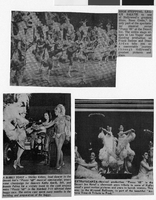
Pzazz! 68, Las Vegas, Nevada: newspaper clippings
Date
Archival Collection
Description
Photograph showing a scrapbook page composed of newspaper clippings that refer to the show Pzazz! 68 in Las Vegas. Transcribed onto the top newspaper clipping: " 'High Stepping, Leggy Salute to one of Hollywood's greatest films, Beau Geste,' is only part of the spectacular musical revue "Pzazz '68" at the Desert Inn. The entire stage erupts in Las Vegas' most dazzling production as Frank Sennes and Donn Arden take you on a memorable journey through Hollywood's greatest pictures and stars." Transcribed onto the bottom left newspaper clipping: "A Bubbly Toast - Shriley Kirkes, lead dancer in the Desert Inn's "Pzazz '68" musical spectacular, pours some Champaign for dancers Kathy Kneib, left, and Bonnie Palma for a victory toast to the cast project entry "Pzazz '68" in the Stardust 7-11 off-road dune buggy race. The entire cast spent many months in the building and preparation of the buggy." Transcribed onto the bottom right newspaper clipping: "Extravaganza-Musical production "Pzazz '68" in the Desert Inn Hotel's showroom pays tribute to some of Hollywood's great motion pictures and stars in lavish scenes. This one, in the Mirrored Ballroom, is part of the beautiful 'Astaire Time-A Tribute to Fred.' "
Show Name: Pzazz! 68
Mixed Content
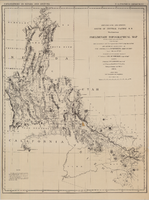
Map of explorations and surveys south of the Central Pacific Railroad made by the U.S. Army Corps of Topographical Engineers, 1871
Date
Description
Image
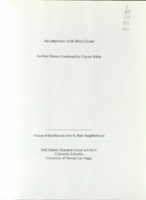
Transcript of interview with Steve Evans by Claytee D. White, June 15, 2010
Date
Archival Collection
Description
Text
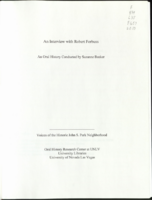
Transcript of interview with Robert Forbuss by Suzanne Becker, February 12, 2009
Date
Archival Collection
Description
In 1944, Robert Forbuss' mother bought a home in a new tract development called Huntridge, adjacent to the John S. Park Neighborhood. She was a single woman who had managed to put together the down payment from her earnings as a cocktail waitress. A couple years later John S. Park Elementary School was built nearby. Through any ups and downs, Marjorie Forbuss refused to live anywhere else for the rest of life, even when Robert encouraged her to move. For this interview, Robert intersperse Las Vegas history while sharing childhood memories of the neighborhood. He graduated from Bishop Gorman High School, the private Catholic prep school, in the mid-1960s. A few years later, Robert returned there as a teacher from 1973 - 1981, teaching kids with familiar last names in the neighborhood he had grown up in. During that time he lived in the John S. Park Neighborhood. He details the charm of the neighborhood, cruising the Downtown area, shopping on Fremont Street and much more. When Robert left teaching, he became the general manger of Mercy Ambulance and Medical Supply, which he ultimately owned until about 2003. During this time, he was a successful business leader and an active community member.
Text
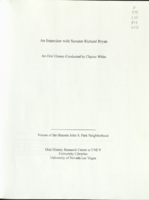
Transcript of interview with Senator Richard Bryan by Claytee White, February 19, 2009
Date
Archival Collection
Description
Text
James Gibson oral history interview
Identifier
Abstract
Oral history interview with James Gibson conducted by Janice Peck on April 13, 1978 for a student project at the University of Nevada, Reno. Gibson discusses coming to Las Vegas, Nevada in 1927, and working for the railroad and in mining, as well as serving in the United States Navy in 1943. He then discusses earning his engineering degree, and becoming an active member of the Democratic Party, and later becoming State Senator for Clark County District 1.
Archival Collection
Membership meetings, 1996-2004
Level of Description
Archival Collection
Collection Name: Nevada Women's History Project Records
Box/Folder: Box 04, Box 05
Archival Component


